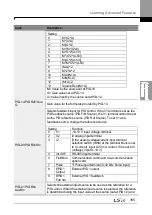
179
Learning Advanced Features
5.9 External PID
External PID refers to the PID features other than the basic PID features required to control
the inverter. The following table shows the areas where external PID controls can be
applied.
Purpose
Function
Speed Control
Controls speed by monitoring the current speed levels of the equipment
or machinery being controlled. Control maintains consistent speed or
operates at the target speed.
Pressure Control
Controls pressure by monitoring the current pressure levels of the
equipment or machinery being controlled. Control maintains consistent
pressure or operates at the target pressure.
Flow Control
Controls flow by monitoring the amount of flow in the equipment or
machinery to be controlled. Control maintains consistent flow or
operates at a target flow.
Temperature
Control
Controls temperature by monitoring the current temperature levels of
the equipment or machinery to be controlled. Control maintains a
consistent temperature or operates at a target temperature.
Depending on the PID output mode, the EPID output value can be overlapped to the PID
output. External output is also available through the analog output settings at OUT-01 and
OUT-07.
Grou
p
Code
Name
LCD Display
Parameter Setting
Setting Range
Unit
EPI
00
Jump Code
Jump Code
40
1
–99
01
EPID 1 Mode
Selection
EPID1 Mode
0
None
0
–3
02
EPID1output
monitor value
EPID1 Output 0.00
-100.00
–
100.00%
Unit
03
EPID1 reference
monitor value
EPID1 Ref
Val
-
-
-
04
EPID1 feedback
monitor value
EPID1 Fdb
Val
-
-
-
05
EPID1error
monitor value
EPID1 Err Val -
-
-
06
EPID1 command
source selection
EPID1 Ref
Src
0
Keypad
0
–10
-
07
EPID1 keypad
command value
EPID1 Ref
Set
Unit Min
Unit Min
–Unit
Max
%
Summary of Contents for H100
Page 14: ......
Page 18: ...Preparing the Installation 4 37 90 kW 3 Phase ...
Page 27: ...Preparing the Installation 13 ...
Page 47: ...33 Installing the Inverter ...
Page 48: ...Installing the Inverter 34 Input and Output Control Terminal Block Wiring Diagram ...
Page 61: ...47 Installing the Inverter ...
Page 71: ...Learning to Perform Basic Operations 57 ...
Page 88: ...Learning to Perform Basic Operations 74 ...
Page 103: ...89 Learning Basic Features Code Description V1 Quantizing ...
Page 129: ...115 Learning Basic Features ...
Page 140: ...Learning Basic Features 126 ...
Page 148: ...Learning Basic Features 134 ...
Page 171: ...157 Learning Advanced Features Deceleration dwell operation ...
Page 183: ...169 Learning Advanced Features ...
Page 184: ...Learning Advanced Features 170 PID Command Block ...
Page 185: ...171 Learning Advanced Features PID Feedback Block ...
Page 186: ...Learning Advanced Features 172 PID Output Block ...
Page 187: ...173 Learning Advanced Features PID Output Mode Block ...
Page 197: ...183 Learning Advanced Features ...
Page 201: ...187 Learning Advanced Features Code Description 100 EPID1 Control block ...
Page 202: ...Learning Advanced Features 188 EPID2 Control block ...
Page 237: ...223 Learning Advanced Features Time Period Schedule AP3 38 Except3 Day 01 01 ...
Page 244: ...Learning Advanced Features 230 ...
Page 259: ...245 Learning Advanced Features Code Description Code Description Volt ...
Page 362: ...Learning Protection Features 348 ...
Page 415: ...401 RS 485 Communication Features Item Standards Parity check None ...
Page 524: ...Table of Functions 510 ...
Page 533: ...Table of Functions 519 ...
Page 547: ...533 Troubleshooting ...
Page 585: ...Technical Specification 571 ...
Page 594: ...580 ...
Page 595: ...581 ...
Page 596: ...582 ...
















































